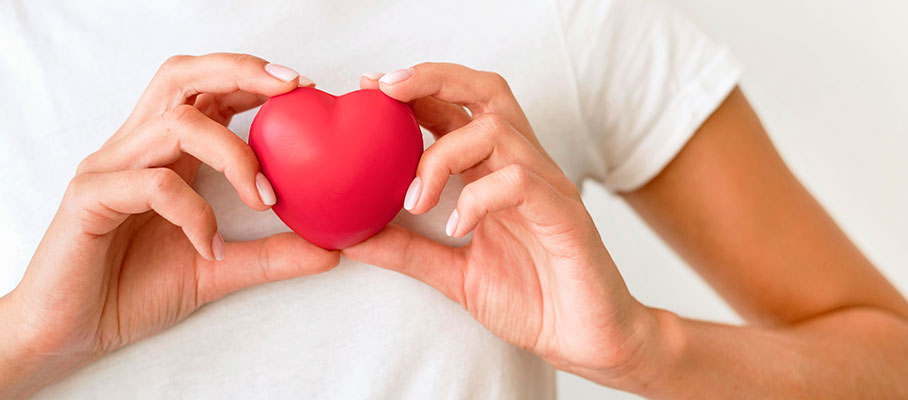Latest Blogs
4 હૃદયના સ્વાસ્થ્ય માટે કોઈપણ હૃદય રોગનું મૂલ્યાંકન કરવા માટે હૃદય રક્ત પરીક્ષણ
શું તમે જાણો છો કે આકસ્મિક રીતે તમારી અનિચ્છનીય ક્રિયાઓ માટે જેને તમે દોષિત ઠરાવો છો તેવું તમારા શરીરનું અતિમહત્ત્વનું અંગ, તમારું હૃદય વાસ્તવમાં તમારી લાગણીઓને ક્યારેય નિયંત્રિત નથી કરતું? તેનું મુખ્ય કાર્ય તમારા સમગ્ર શરીરમાં લોહી, ઓક્સિજન અને પોષક તત્ત્વોનું પમ્પિંગ કરવાનું છે. માનવહૃદય દરરોજ 100,000થી વધારે વાર ધબકે છે અને દર મિનિટે લગભગ 1.5 ગેલન લોહી પમ્પ કરે છે. હૃદય પોતાને અતિસક્રિય રાખે છે જેથી તમે પણ આગળ વધી શકો. પરંતુ શું તમે તમારા હૃદયની પૂરતી કાળજી લો છો ? વિશ્વમાં સૌથી ઝડપથી વિકસતા દેશ ભારતમાં હ્રદયરોગ સૌથી વધુ ઝડપથી વકરતી સ્વાસ્થ્ય સમસ્યાઓમાંની એક બની છે. વર્લ્ડ હેલ્થ ઓર્ગેનાઈઝેશ(WHO) અનુસાર, હૃદયરોગથી થતા મૃત્યુમાં દર પાંચમાંથી ચારથી વધુ વખત મુખ્ય કારણ હાર્ટ એટેક અને સ્ટ્રોકને કારણે થાય છે અને તેમાંથી એક તૃતાંક્ષ ભાગનાં મૃત્યુ 70 વર્ષથી ઓછી ઉંમરના લોકોનાં અકાળે થાય છે. તમારી બેઠાડુ જીવનશૈલીને તમારા આરોગ્ય માટેનો પ્રોબ્લમ ન બનવા દેશો કારણ કે આળસુ અને બેઠાડુ જીવન સૌથી મોટી સમસ્યા બની શકે છે. અમારા ટ્રૂહેલ્થ હેલ્થ પેકેજ(TruHealth Health Package) દ્વારા તમારા હેલ્થ પેરામીટરને ચકાસતા રહો. હેલ્થ ટેસ્ટ સાથે હૃદયની ઊભરતી સમસ્યાઓ વિશે સચેત રહો ધૂમ્રપાન, હાઈ બ્લડ પ્રેશર, હાઈ કોલેસ્ટ્રોલ અને ડાયાબિટીસ-એ હૃદયની સ્થિતિ માટેનાં કેટલાંક સામાન્ય જોખમી પરિબળો છે. તમારા હૃદયરોગના જોખમને ઓળખવામાં તમારા ડોક્ટર તમારી મદદ કરવા માટે શ્રેષ્ઠ માર્ગદર્શક હોવા છતાં, એ જાણવું અગત્યનું છે કે કેટલાક હૃદય સંબંધિત બ્લડ ટેસ્ટ હૃદયની સ્થિતિની ચકાસણી, નિદાન અને તેનું સંચાલન કરવા માટે ઘણા મહત્ત્વના છે. હૃદયરોગના નિદાન માટે મહત્ત્વના હાર્ટ બ્લડ ટેસ્ટનું લિસ્ટ : 1. લિપિડ પ્રોફાઇલ ટેસ્ટ આને કોલેસ્ટ્રોલ ટેસ્ટ પણ કહેવાય છે. આ ટેસ્ટ તમારા લોહીમાં રહેલી ચરબીનું પ્રમાણ માપે છે અને હૃદયરોગના હુમલા, સ્ટ્રોક અથવા અન્ય હૃદયરોગ થવાના જોખમ તરફ નિર્દેશ કરે છે. આ પરીક્ષણમાં સામાન્ય રીતે નીચે વર્ણવેલી વિવિધ બાબતોના સૂચકઆંક પણ દર્શાવાય છે : કોલેસ્ટ્રોલ : તમારા લોહીમાં રહેલા કોલેસ્ટ્રોલની માત્રાને દર્શાવે છે. કુલ કોલેસ્ટ્રોલનું ઊંચી માત્રા તમારા હૃદયરોગનું જોખમ વધારે છે. સામાન્ય રીતે તમારું કુલ કોલેસ્ટ્રોલ લેવલ 200 મિલિગ્રામ પ્રતિ ડેસિલિટર (mg/dL) અથવા 5.2 મિલિમોલ્સ પ્રતિ લિટર (mmol/L)થી ઓછું હોવું જોઈએ. હાઈ-ડેન્સિટી લિપોપ્રોટીન (HDL) કોલેસ્ટ્રોલ : "સારા" કોલેસ્ટ્રોલ તરીકે પણ ઓળખાય છે. તે ધમનીઓને ખુલ્લી રાખવામાં અને તમારા લોહીને વધુ મુક્ત રીતે વહેવામાં મદદ કરે છે. લો-ડેન્સિટી લિપોપ્રોટીન (LDL) કોલેસ્ટ્રોલ : તેને "ખરાબ" કોલેસ્ટ્રોલ પણ કહેવામાં આવે છે. તમારા લોહીમાં વધારે પડતું LDL કોલેસ્ટ્રોલ તમારી રક્તવાહિનીઓમાં પ્લેક જમા થવા તરફ દોરી શકે છે અને પરિણામે લોહીના પરિભ્રમણમાં ઘટાડો થાય છે. આ પ્લેકક્લોટિંગ ફાટી શકે છે અને હૃદય અને રક્ત વાહિનીઓની મોટી સમસ્યાઓનું કારણ બની શકે છે. ટ્રાઇગ્લિસરાઈડ્સ: આ લોહીમાં રહેલી વધુ એક પ્રકારની ચરબી છે, જેનું ઉચ્ચ સ્તર તમારા હૃદયરોગનું જોખમ વધારી શકે છે. તમારું ટ્રાઇગ્લિસેરાઇડનું સ્તર 150 mg/dL (1.7 mmol/L) કરતાં ઓછું હોવું જોઈએ. 2. ઉચ્ચ-સંવેદનશીલ C-રિએક્ટિવ પ્રોટીન ટેસ્ટ (hs CRP Test) સી-રિએક્ટિવ પ્રોટીન (CRP)એ એક પ્રોટીન છે, જે તમારા લિવર દ્વારા ઈજા અથવા ચેપને કારણે શરીરના બળતરા પ્રત્યેના પ્રતિભાવના ભાગ રૂપે ઉત્પન્ન થાય છે. hs-CRP ટેસ્ટ તમારા લોહીમાં C-રિએક્ટિવ પ્રોટીન (CRP)ના નીચા સ્તરને ચકાસે છે. વધેલા એચએસ-સીઆરપી પરીક્ષણ મૂલ્યો હાર્ટ એટેક, સ્ટ્રોક અને કાર્ડિયોવેસ્ક્યુલર રોગના ઊંચા જોખમને દર્શાવે છે. તમને લક્ષણો દેખાય તે પહેલાં જ તમારા હૃદયરોગના જોખમને નક્કી કરવામાં મદદ કરી શકતો હોવાથી આ બ્લડ ટેસ્ટ હૃદયની સ્થિતિનું નિદાન કરવામાં ખૂબ મહત્વ ધરાવે છે. 2.0 mg/L ઉપરનું hs-CRP સ્તર હૃદયરોગના વધતા જોખમનું સૂચક માનવામાં આવે છે. જોકે વાયરલ ઇન્ફેક્શન જેવી હ્રદયરોગ સિવાયની અન્ય ઘણી પરિસ્થિતિઓમાં પણ સીઆરપીનું સ્તર અસ્થાયી ધોરણે વધી જાય છે. તેથી કેટલાક તબીબી નિષ્ણાતો બે અઠવાડિયાના અંતરે બે વાર પરીક્ષણ કરવાનું સૂચન પણ કરી શકે છે. યાદ રાખવા જેવી વાત એ છે કે માત્ર એચએસ-સીઆરપી લેવલને આધારે કોઈ નિષ્કર્ષે પહોંચવું એ ભૂલ ભરેલું ગણાશે. તમારા ડૉક્ટર અન્ય હેલ્થ ટેસ્ટ માટે પણ કહી શકે છે. તે તમામ ટેસ્ટનાં પરિણામોને આધારે હૃદયના સ્વાસ્થ્યની એકંદર સમજ મેળવી શકાય છે અને તમારા હ્રદય સંબંધિત જોખમી પરિબળો સાથે જોડી શકાય છે. 3 . નેટ્રિયુરેટિક પેપ્ટાઇડ(Natriuretic peptides) બ્રેઈન નેટ્રિયુરેટિક પેપ્ટાઈડ(BNP) તમારા હૃદય અને રક્તવાહિનીઓ દ્વારા બનાવવામાં આવતું એક પ્રોટીન છે, જે તમારા શરીરને પ્રવાહીને દૂર કરવામાં, રક્તવાહિનીઓને આરામ કરવા અને તમારા પેશાબ દ્વારા સોડિયમ બહાર કાઢવામાં મદદ કરે છે. તમારા હૃદયને જ્યારે નુકસાન થાય છે, ત્યારે તમારા લોહીમાં પ્રવેશતા BNPનું લેવલ વધે છે. ઉંમર, લિંગ અને વજનને આધારે દરેક વ્યક્તિનું નોર્મલ BNP લેવલ અલગ-અલગ હોઈ શકે છે. કન્જેસ્ટિવ હાર્ટ ફેલ્યોર (CHF)ની ગંભીરતાને શોધવા, નિદાન કરવા અને મૂલ્યાંકન કરવા માટે મદદની જરૂર છે ? તો આજે જ તમારા લોહીમાં રહેલા BNP અથવા NT-pro BNPના લેવલને માપવા એનટી-પ્રો બીએનપી સીરમ ટેસ્ટ બુક કરો. 4. હાર્ટ એટેક માટે ટ્રોપોનિન(T) ટેસ્ટ ટ્રોપોનિન (અથવા કાર્ડિયાક ટ્રોપોનિન)એ તમારા હૃદયના સ્નાયુઓમાં જોવા મળતા પ્રોટીનનો એક પ્રકાર છે. તે સામાન્ય રીતે લોહીમાં જોવા મળતું નથી અને જ્યારે હૃદયના સ્નાયુઓને નુકસાન થાય છે ત્યારે જ તે મુક્ત થઈને લોહીમાં ભળે છે. ટ્રોપોનિન ટેસ્ટ તમારા લોહીમાં ટ્રોપોનિનનું સ્તર ચકાસે છે. જેમ જેમ હૃદયના સ્નાયુઓને વધારે ને વધારે નુકસાન થશે તેમ તેમ વધુ પ્રમાણમાં ટ્રોપોનિન લોહીમાં મુક્ત થાય છે. હૃદયની ઇજા અથવા નુકસાનને ઓળખવા માટે બે પ્રકારના કાર્ડિયાક ટ્રોપોનિન T (cTnT) અને I (cTnI)નો ઉપયોગ કાર્ડિયાક પ્રોફાઇલ ટેસ્ટ તરીકે થાય છે. લોહીમાં ટ્રોપોનિનનું ઊંચું સ્તર સૂચવે છે કે તમને હાર્ટ એટેક આવ્યો છે અથવા તાજેતરમાં થયો હતો. કેટલાક રિસર્ચમાં જાણવા મળ્યું છે કે હાર્ટ એટેક માટે ટ્રોપોનિન ટી બ્લડ ટેસ્ટ કરતાં ટ્રોપોનિન I વધુ ચોક્કસ અને વધુ સારું કાર્ડિયાક સૂચક છે. નોંધનીય છે કે માત્ર એક હાર્ડ બ્લડ ટેસ્ટ તમારા હૃદયરોગના એકંદર જોખમને નિર્ધારિત કરી શકશે નહીં. જો તમને લાગતું હોય કે તમારી લાઈફસ્ટાઈલ અથવા ફેમિલી હિસ્ટ્રી તમને નાની ઉંમરે હૃદયરોગ થવાનું જોખમ ઊભું કરી શકે છે, તો ડૉક્ટરનો સંપર્ક કરો, સલાહ મુજબ હાર્ટ બ્લોકેઝ અને હૃદયરોગ માટેના બ્લડ ટેસ્ટ બુક કરો અને તમારી લાઈફસ્ટાઈલની આદતોમાં સુધારો કરો.









